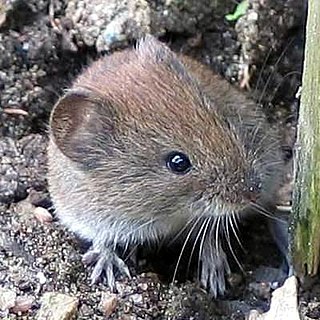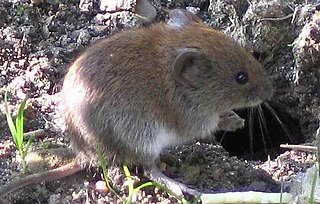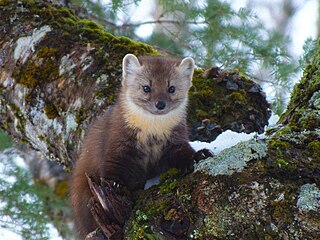
The Arvicolinae are a subfamily of rodents that includes the voles, lemmings, and muskrats. They are most closely related to the other subfamilies in the Cricetidae. Some authorities place the subfamily Arvicolinae in the family Muridae along with all other members of the superfamily Muroidea. Some refer to the subfamily as the Microtinae or rank the taxon as a full family, the Arvicolidae.

Red-backed voles are small, slender voles of the genus Clethrionomys found in North America, Europe, and Asia. In recent years the genus name was changed to Myodes, however a 2019 paper found that Myodes was actually a junior synonym for Lemmus, thus making it unusable. As such, Clethrionomys is re-established as the proper genus name.

The northern red-backed vole is a small slender vole found in Alaska, northern Canada, Scandinavia and northern Russia.

Eimeria is a genus of apicomplexan parasites that includes various species capable of causing the disease coccidiosis in animals such as cattle, poultry and smaller ruminants including sheep and goats. Eimeria species are considered to be monoxenous because the life cycle is completed within a single host, and stenoxenous because they tend to be host specific, although a number of exceptions have been identified. Species of this genus infect a wide variety of hosts. Thirty-one species are known to occur in bats (Chiroptera), two in turtles, and 130 named species infect fish. Two species infect seals. Five species infect llamas and alpacas: E. alpacae, E. ivitaensis, E. lamae, E. macusaniensis, and E. punonensis. A number of species infect rodents, including E. couesii, E. kinsellai, E. palustris, E. ojastii and E. oryzomysi. Others infect poultry, rabbits and cattle. For full species list, see below.

The bank vole is a small vole with red-brown fur and some grey patches, with a tail about half as long as its body. A rodent, it lives in woodland areas and is around 100 millimetres (3.9 in) in length. The bank vole is found in much of Europe and in northwestern Asia. It is native to Great Britain but not to Ireland, where it has been accidentally introduced, and has now colonised much of the south and southwest.

The grey red-backed vole or the grey-sided vole is a species of vole. An adult grey red-backed vole weighs 20-50 grams. This species ranges across northern Eurasia, including northern China, the northern Korean Peninsula, and the islands of Sakhalin and Hokkaidō. It is larger and longer-legged than the northern red-backed vole, which covers a similar range and it is also sympatric with the Norwegian lemming.

The western red-backed vole is a species of vole in the family Cricetidae. It is found in California and Oregon in the United States and lives mainly in coniferous forest. The body color is chestnut brown, or brown mixed with a considerable quantity of black hair gradually lightening on the sides and grading into a buffy-gray belly, with an indistinct reddish stripe on the back and a bicolored tail about half as long as the head and body.

The Myodini are a tribe of forest voles in the subfamily Arvicolinae. Species in this tribe are:

The Newfoundland pine marten is a genetically distinct subspecies of the American marten found only on the island of Newfoundland in the province of Newfoundland and Labrador, Canada; it is one of only 14 species of land mammals native to the island. The marten was listed as endangered by the COSEWIC in 2001 and has been protected since 1934, however the population still declines. The Newfoundland marten has been geographically and reproductively isolated from the mainland marten population for 7000 years. The Newfoundland pine marten is similar in appearance to its continental cousin, but is slightly larger, with dark brown fur with an orange/yellow patch on the throat. Females are an average weight of 772 grams and males have an average weight of 1275 grams. The Newfoundland subspecies is also observed to inhabit a wider range of forest types than its mainland counterparts. The population characteristics suggest that the Newfoundland marten is a product of unique ecological setting and evolutionary selective factors acting on the isolated island population. The Newfoundland pine marten is omnivorous, feeding on mainly small mammals, along with birds, old carcasses, insects and fruits; it is currently found in suitable pockets of mature forest habitat, on the west coast of Newfoundland and in and around Terra Nova National Park. The Pine Marten Study Area (PMSA) is located in southwestern Newfoundland and is a 2078 km2 wildlife reserve that was created in 1973 to protect the Newfoundland Marten.
Euschoengastia peromysci is a mite in the genus Euschoengastia of the family Trombiculidae. Recorded hosts include the cotton mouse and marsh rice rat in Georgia; the northern short-tailed shrew, northern red-backed vole, northern flying squirrel, rock vole, white-footed mouse, and deermouse in Tennessee; and northern red-backed vole, southern bog lemming, masked shrew, and eastern red squirrel in North Carolina, among others.
Listrophorus is a genus of parasitic mites in the family Listrophoridae. North American species with their hosts include:
Frenkelia is a genus of parasites in the phylum Apicomplexa. The species in this genus infect the gastrointestinal tracts of birds of prey and the tissues of small rodents.

There are 67 native species of mammals in Rocky Mountain National Park, a 265,461 acres (107,428 ha) park in Colorado. Species are listed by common name, scientific name, habitat, and abundance. Species which are extirpated, or locally extinct, are marked with an EX.









